John F. Kennedy International Airport
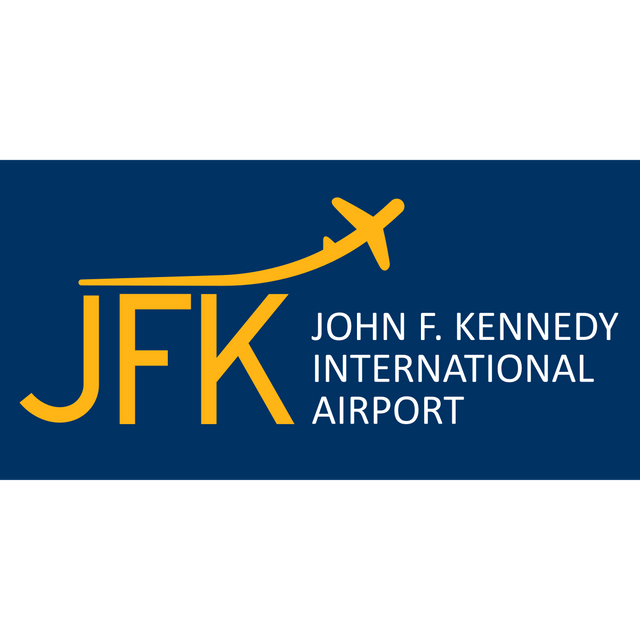
John F. Kennedy International Airport

John F. Kennedy International Airport | |||||||||||||||||||||||
|---|---|---|---|---|---|---|---|---|---|---|---|---|---|---|---|---|---|---|---|---|---|---|---|
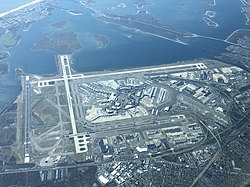 Aerial shot of JFK Airport on November 14, 2018 | |||||||||||||||||||||||
| Summary | |||||||||||||||||||||||
| Airport type | Public | ||||||||||||||||||||||
| Owner | City of New York[1] | ||||||||||||||||||||||
| Operator | Port Authority of New York and New Jersey[1] | ||||||||||||||||||||||
| Serves | New York metropolitan area | ||||||||||||||||||||||
| Location | Queens, New York, U.S. | ||||||||||||||||||||||
| Opened | July 1, 1948 (1948-07-01) | ||||||||||||||||||||||
| Hub for | |||||||||||||||||||||||
| Focus city for |
| ||||||||||||||||||||||
| Time zone | EST (UTC−05:00) | ||||||||||||||||||||||
| • Summer (DST) | EDT (UTC−04:00) | ||||||||||||||||||||||
| Elevation AMSL | 13 ft / 4 m | ||||||||||||||||||||||
| Coordinates | 40°38′23″N 073°46′44″W [304] | ||||||||||||||||||||||
| Website | jfkairport.com [305] | ||||||||||||||||||||||
| Maps | |||||||||||||||||||||||
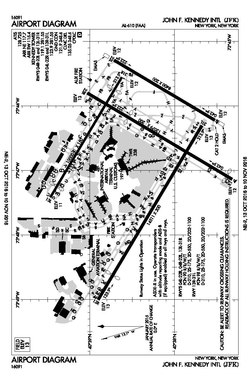 FAA airport diagram as of October 2016 | |||||||||||||||||||||||
| Runways | |||||||||||||||||||||||
| |||||||||||||||||||||||
| Helipads | |||||||||||||||||||||||
| |||||||||||||||||||||||
| Statistics (2018) | |||||||||||||||||||||||
| |||||||||||||||||||||||
Source: Port Authority of New York and New Jersey[3] | |||||||||||||||||||||||
John F. Kennedy International Airport (IATA: JFK, ICAO: KJFK, FAA LID: JFK) (colloquially referred to as New York-JFK, New York-Kennedy, Kennedy Airport, JFK Airport, JFK or Kennedy) is an international airport in Queens, New York. It is the primary international airport serving New York City. The airport is the busiest international air passenger gateway into North America,[4] the 22nd-busiest airport in the world, the sixth-busiest airport in the United States, and the busiest airport in the New York airport system, having handled just over 59 million passengers in 2017.[5] More than ninety airlines operate from the airport, with nonstop or direct flights to destinations in all six inhabited continents.[6][7]
JFK is located in the Jamaica neighborhood of Queens in New York, 16 miles (26 km) southeast of Midtown Manhattan. The airport features six passenger terminals and four runways. It serves as a hub for both American Airlines and Delta Air Lines, and it is the primary operating base for JetBlue. JFK was also formerly a hub for Pan Am, TWA, Eastern, National, and Tower Air.
The facility opened in 1948 as New York International Airport[8][9] and was commonly known as Idlewild Airport.[10] Following John F. Kennedy's assassination in 1963, the airport was renamed John F. Kennedy International Airport as a tribute to the 35th President.[11][12][13]
John F. Kennedy International Airport | |||||||||||||||||||||||
|---|---|---|---|---|---|---|---|---|---|---|---|---|---|---|---|---|---|---|---|---|---|---|---|
 Aerial shot of JFK Airport on November 14, 2018 | |||||||||||||||||||||||
| Summary | |||||||||||||||||||||||
| Airport type | Public | ||||||||||||||||||||||
| Owner | City of New York[1] | ||||||||||||||||||||||
| Operator | Port Authority of New York and New Jersey[1] | ||||||||||||||||||||||
| Serves | New York metropolitan area | ||||||||||||||||||||||
| Location | Queens, New York, U.S. | ||||||||||||||||||||||
| Opened | July 1, 1948 (1948-07-01) | ||||||||||||||||||||||
| Hub for | |||||||||||||||||||||||
| Focus city for |
| ||||||||||||||||||||||
| Time zone | EST (UTC−05:00) | ||||||||||||||||||||||
| • Summer (DST) | EDT (UTC−04:00) | ||||||||||||||||||||||
| Elevation AMSL | 13 ft / 4 m | ||||||||||||||||||||||
| Coordinates | 40°38′23″N 073°46′44″W [304] | ||||||||||||||||||||||
| Website | jfkairport.com [305] | ||||||||||||||||||||||
| Maps | |||||||||||||||||||||||
 FAA airport diagram as of October 2016 | |||||||||||||||||||||||
| Runways | |||||||||||||||||||||||
| |||||||||||||||||||||||
| Helipads | |||||||||||||||||||||||
| |||||||||||||||||||||||
| Statistics (2018) | |||||||||||||||||||||||
| |||||||||||||||||||||||
Source: Port Authority of New York and New Jersey[3] | |||||||||||||||||||||||
History
Construction and early operations
John F. Kennedy International Airport was originally called Idlewild Airport (IATA: IDL, ICAO: KIDL, FAA LID: IDL) after the Idlewild Beach Golf Course that it displaced. It was built to relieve LaGuardia Field, which had become overcrowded after its 1939 opening. Construction began in 1943,[14] and about US$60 million was initially spent with governmental funding, but only 1,000 acres (400 ha) of the Idlewild Golf Course site were earmarked for use.[15]
In 1943, the project was renamed Major General Alexander E. Anderson Airport, after a Queens resident who had commanded a Federalized National Guard unit in the southern United States and died in late 1942. In March 1948, the New York City Council changed the name to New York International Airport, Anderson Field, but the common name was "Idlewild" until the end of 1963.[12][16]
The Port of New York Authority (now the Port Authority of New York and New Jersey) leased the Idlewild property from the City of New York in 1947 and maintains this lease today.[1] The first flight from Idlewild was on July 1, 1948; the opening ceremony was attended by then U.S. President Harry S. Truman.[15][17] The Port Authority canceled foreign airlines' permits to use LaGuardia, forcing them to move to Idlewild during the next couple of years.[18]
Idlewild opened with six runways and a seventh under construction;[19] runways 1L and 7L were held in reserve and never came into use as runways. Runway 31R (originally 8,000 ft or 2,438 m) is still in use; runway 31L (originally 9,500 ft or 2,896 m) opened soon after the rest of the airport and is still in use; runway 1R closed in 1957 and runway 7R closed around 1966. Runway 4 (originally 8,000 ft, now runway 4L) opened June 1949 and runway 4R was added ten years later. A smaller runway 14/32 was built after runway 7R closed and was used until 1990[20] by general aviation, STOL, and smaller commuter flights.
The Avro Jetliner was the first jet airliner to land at Idlewild on April 16, 1950. A Sud Aviation Caravelle prototype was the next airliner to land at Idlewild, on May 2, 1957. Later in 1957, the USSR sought approval for two Tupolev Tu-104 flights carrying diplomats to Idlewild; the Port Authority did not allow them, saying noise tests had to be done first. (The Caravelle had been tested at Paris.) The airport was renamed John F. Kennedy International Airport on December 24, 1963, a month and two days after the assassination of President John F. Kennedy;[21] Mayor Robert F. Wagner, Jr. proposed the renaming to JFK.[22] The IDL and KIDL codes have since been reassigned to Indianola Municipal Airport in Mississippi.[23]
Development
The Port of New York Authority originally planned a single 55-gate terminal, but the major airlines did not agree with this plan, arguing that the terminal would be far too small for future traffic.[24] Architect Wallace Harrison then designed a plan for each major airline at the airport to be given its own space to develop its own terminal.[25] This scheme made construction more practical, made terminals more navigable, and introduced incentives for airlines to compete with each other for the best design.[24] The revised plan met airline approval in 1955, with seven terminals initially planned. Five terminals were for individual airlines, one was for three airlines, and one was for international arrivals. (National Airlines and British Airways arrived later.)[16] The airport was designed for aircraft up to 300,000-pound (140,000 kg) gross weight[26] The airport had to be modified in the late 1960s to accommodate the Boeing 747's weight.[27]
The International Arrivals Building, or IAB, was the first new terminal at the airport, opening in December 1957. The building was designed by Skidmore, Owings and Merrill. The terminal stretched nearly 700 meters (2,300 ft) and was parallel to runway 7R. The terminal had "finger" piers at right-angles to the main building allowing more aircraft to park, an innovation at the time.[16] The building was expanded in 1970 to accommodate jetways. However, by the 1990s the overcrowded building was showing its age and it did not provide adequate space for security checkpoints. It was demolished in 2000 and replaced with Terminal 4.
United Airlines and Delta Air Lines[28] opened Terminal 7 (later renumbered Terminal 9), a Skidmore design similar to the IAB, in October 1959. It was demolished in 2008.
American Airlines opened Terminal 8 in 1960. It was designed by Kahn and Jacobs[16] and had a 317-foot (97 m) stained-glass façade designed by Robert Sowers, the largest stained-glass installation in the world until 1979. The façade was removed in 2007 as the terminal was demolished to make room for the new Terminal 8; American cited the prohibitive cost of removing the enormous installation.[30]
Pan American World Airways opened the Worldport (later Terminal 3) in 1960. It featured a large, elliptical roof suspended by 32 sets of radial posts and cables; the roof extended 114 feet (35 m) beyond the base of the terminal to cover the passenger loading area. It was one of the first airline terminals in the world to feature Jetways that connected to the terminal and that could be moved to provide an easy walkway for passengers from the terminal to a docked aircraft. Jetways replaced the need to have to board the plane outside via airstairs, which descend from an aircraft, via truck-mounted mobile stairs or via wheeled stairs.[31] The Worldport was demolished in 2013.
Trans World Airlines opened the TWA Flight Center in 1962, designed by Eero Saarinen with a distinctive winged-bird shape. With the demise of TWA in 2001, the terminal remained vacant until 2005 when JetBlue Airways and the Port Authority of New York and New Jersey (PANYNJ) financed the construction of a new 26-gate terminal partly encircling the Saarinen building. Called Terminal 5(Now T5), the new terminal opened October 22, 2008. T5 is connected to the Saarinen central building through the original passenger departure-arrival tubes that connected the building to the outlying gates. The original Saarinen terminal, also known as the head house, has since been converted into the TWA Hotel.[32]
Northwest Airlines, Braniff International, and Northeast Airlines opened a joint terminal in 1962 (now Terminal 2).[31]
National Airlines opened the Sundrome (now Terminal 6) in 1970. The terminal was designed by I.M.Pei. It was unique for its use of all-glass mullions dividing the window sections, unprecedented at the time.[33] In 2001, United Airlines planned to redevelop this terminal and the TWA Flight Center as a new United terminal.[34] Terminal 6 was used by JetBlue from 2001 through 2008, and then was vacated and demolished when JetBlue moved to Terminal 5.
Operation
In 1951, the airport averaged 73 daily airline operations (takeoffs plus landings); the October 1951 Airline Guide shows nine domestic departures a day on National and Northwest. Much of Newark's traffic moved to Idlewild (which averaged 242 daily airline operations in 1952) when Newark closed in February 1952. L-1049 Constellations and DC-7s appeared between 1951 and 1953 and did not use LaGuardia for their first several years, bringing more traffic to Idlewild. The April 1957 Airline Guide cites a total of 1283 departures a week, including about 250 from Eastern Air Lines, 150 from National Airlines and 130 from Pan American.
Airlines began scheduling jets to Idlewild in 1958–59; LaGuardia did not get jets until 1964, and Idlewild became New York's busiest airport. It had more airline takeoffs and landings than LaGuardia and Newark combined from 1962 to 1967 and was the second-busiest airport in the country, peaking at 403,981 airline operations in 1967. LaGuardia received a new terminal and longer runways from 1960 to 1966. By the mid- 1970s, the two airports had roughly-equal airline traffic (by flight count); Newark was in third place until the 1980s, except during LaGuardia's reconstruction. The Concorde, operated by Air France and British Airways, made scheduled trans-Atlantic supersonic flights to JFK from November 22, 1977 until its retirement by British Airways on October 24, 2003.[35][36][37] Air France had retired the aircraft in May 2003.
Construction of the AirTrain JFK rapid-transit system began in 1998, after decades of planning for a direct rail link to the airport.[38][39] Although the system was originally scheduled to open in 2002,[40] it opened on December 17, 2003 after delays caused by construction and a fatal crash.[41] The rail network links each airport terminal to the New York City Subway and the Long Island Rail Road at Howard Beach and Jamaica.[42][43]
The airport's new Terminal 1 opened on May 28, 1998; Terminal 4, the $1.4 billion replacement for the International Arrivals Building, opened on May 24, 2001.[44][45] JetBlue's Terminal 5 incorporates the TWA Flight Center, and Terminals 8 and 9 were demolished and rebuilt as Terminal 8 for the American Airlines hub. The Port Authority Board of Commissioners approved a $20 million planning study for the redevelopment of Terminals 2 and 3, the Delta Air Lines hub, in 2008.[46]
On March 19, 2007, JFK was the first airport in the United States to receive a passenger Airbus A380 flight. The route, with an over-500-passenger capacity, was operated by Lufthansa and Airbus and arrived at Terminal 1. On August 1, 2008, it received the first regularly-scheduled commercial A380 flight to the United States (on Emirates' New York–Dubai route) at Terminal 4.[47] Although the service was suspended in 2009 due to poor demand,[48] the aircraft was reintroduced in November 2010. Airlines operating A380s to JFK include Singapore Airlines (on its New York–Frankfurt–Singapore route),[49] Air France (on its New York–Paris–Charles de Gaulle route), Lufthansa (on its New York–Frankfurt route), Korean Air and Asiana Airlines (on their New York–Seoul route), Etihad Airways on its New York–Abu Dhabi route, and Emirates (on its New York–Milan–Dubai and New York–Dubai routes).[50] On December 8, 2015, JFK was the first U.S. airport to receive a commercial Airbus A350 flight when Qatar Airways began using the aircraft on its New York–Doha route.[51]
On August 14, 2016, at 9:31 pm, gunfire was reported at Terminal 8; shortly afterward, gunfire was also reported at Terminal 1. An investigation indicated that no shooting had occurred, but frightened travelers ran from the terminals onto nearby highways and runways.[52][53] The terminals were temporarily shut down, and flights were rerouted.[54] Police, who were investigating, learned that the reported gunshots were travelers clapping for Usain Bolt after he won the men's 100-meter dash at the 2016 Summer Olympics.[52] Two people were injured in the resulting stampede, and the Port Authority Police Department later reviewed its strategy for dealing with possible terror attacks.[53]
Future
On January 4, 2017, the office of New York governor Andrew Cuomo announced a plan to renovate the airport at a cost of $7 to 10 billion. The Airport Master Plan Advisory Panel had reported that JFK, ranked 59th out of the world's top 100 airports by Skytrax, was expected to experience severe capacity constraints from increased use.[55][56] The airport was expected to serve about 75 million annual passengers in 2020 and 100 million by 2050, up from 60 million when the report was published.[55] The panel had several recommendations, including enlarging the newer terminals; relocating older terminals; reconfiguring highway ramps and increasing the number of lanes on the Van Wyck Expressway; lengthening AirTrain JFK trainsets or connecting the line to the New York City transportation system, and rebuilding the Jamaica station with direct connections to the Long Island Rail Road and the New York City Subway.[57] No start date has yet been proposed for the project;[56] in July 2017, Cuomo's office began accepting proposals for master plans to renovate the airport.[58][59]
In October 2018, Cuomo released details of a $13 billion plan to rebuild passenger facilities and approaches to JFK Airport. Two new international terminals would be added. One of the terminals, a $7 billion, 23-gate structure replacing terminals 1 and 2 and connecting to Terminal 4, would be financed and built by a partnership between Lufthansa, Air France, Korean Airlines, and Japan Airlines.[60][61] The other terminal, costing $3 billion, would be developed by JetBlue and will replace Terminal 7 and the vacant space of Terminal 6, and would connect to Terminal 5. Terminal 8 would remain a separate terminal operating American Airlines and Oneworld flights.[60][62][63] JFK's redesign will include adding cars to AirTrain trainsets; widening connector ramps between the Van Wyck Expressway and Grand Central Parkway in Kew Gardens; and adding another lane in each direction to the Van Wyck, at a combined cost of $1.5 billion.[60][64] If approved, construction is expected to begin in 2020. Under the plan, the first gates would open in 2023, and the project would be complete in 2025.[62][63]
Terminals
JFK has six terminals, containing 128 gates, numbered 1–8 but skipping terminals 3 (demolished in 2013) and 6 (demolished in 2011).
The terminal buildings, with the exception of the former Tower Air terminal, are arranged in a deformed U-shaped wavy pattern around a central area containing parking, a power plant and other airport facilities. The terminals are connected by the AirTrain system and access roads. Directional signage throughout the terminals was designed by Paul Mijksenaar.[65] A 2006 survey by J.D. Power and Associates in conjunction with Aviation Week found JFK ranked second in overall traveler satisfaction among large airports in the United States, behind McCarran International Airport, which serves the Las Vegas metropolitan area.[66]
Until the early 1990s, each terminal was known by the primary airline that served it, except for Terminal 4, which was known as the International Arrivals Building. In the early 1990s, all of the terminals were given numbers except for the Tower Air terminal, which sat outside the Central Terminals area and was not numbered. Like in the other airports controlled by the Port Authority, terminals are sometimes managed and maintained by independent terminal operators. At JFK, all terminals are currently managed by airlines or consortiums of the airlines serving them, with the exception of the Schiphol Group-operated Terminal 4. All terminals except Terminal 2 can handle international arrivals that are not pre-cleared.
Most inter-terminal connections require passengers to exit security, then walk, use a shuttle bus, or use the AirTrain JFK to get to the other terminal, then re-clear security.
Current terminals
Terminal 1
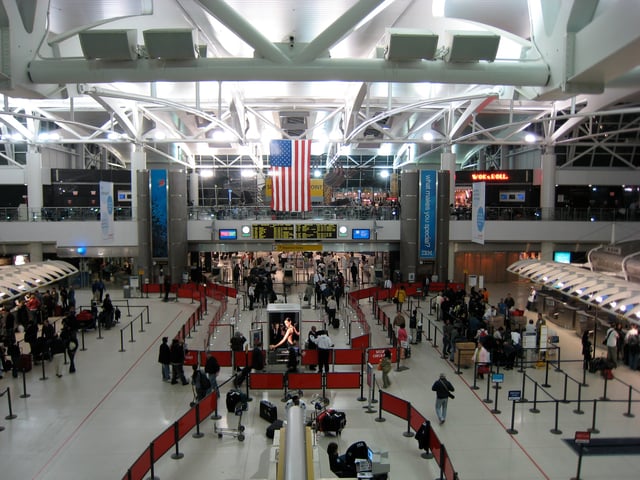
Terminal 1
Terminal 1 opened in 1998, 50 years after the opening of JFK, at the direction of the Terminal One Group, a consortium of four key operating carriers: Air France, Japan Airlines, Korean Air, and Lufthansa.[67] This partnership was founded after the four airlines reached agreement that the then-existing international carrier facilities were inadequate for their needs.
Terminal 1 is served by SkyTeam carriers Aeroflot, Air France, Alitalia, China Eastern Airlines, Korean Air, and Saudia; Star Alliance carriers Air China, Austrian Airlines, Brussels Airlines, EVA Air, Lufthansa, and Turkish Airlines; and Oneworld carrier Japan Airlines. Other airlines serving terminal 1 include Air Italy, Azerbaijan Airlines, Cayman Airways, Interjet,[68] Norwegian Air, Philippine Airlines, Royal Air Maroc, and VivaAerobus.[69]
Terminal 1 was designed by William Nicholas Bodouva + Associates.[70] It and Terminal 4 are the two terminals at JFK Airport with the capability of handling the Airbus A380 aircraft, which are flown by Air France on the route from Paris–Charles De Gaulle, by Lufthansa on the route from Frankfurt Airport, and by Korean Air on the route from Seoul–Incheon. Air France operated Concorde here until 2003.[71] Terminal 1 has 11 gates.[72]
Terminal 2
Terminal 2 opened in 1962 as the home of Northeast Airlines, Braniff, and Northwest Airlines, and is now exclusively used and operated by Delta Air Lines. After the demise of Northeast Airlines and Braniff, the terminal was taken over by Pan American World Airways and subsequently by Delta. Since the opening of the Terminal 4 addition in May 2013, Terminal 2 has been designated as the C gates by Delta and has 11 Jetway-equipped gates (C60-C70). Terminal 2 used to house the majority of Delta's operations, but after the opening of the Terminal 4 addition, the majority of flights are now handled out of the latter. International and flights to LAX, SFO, and SEA check-in at Terminal 4.[73]
Terminal 4
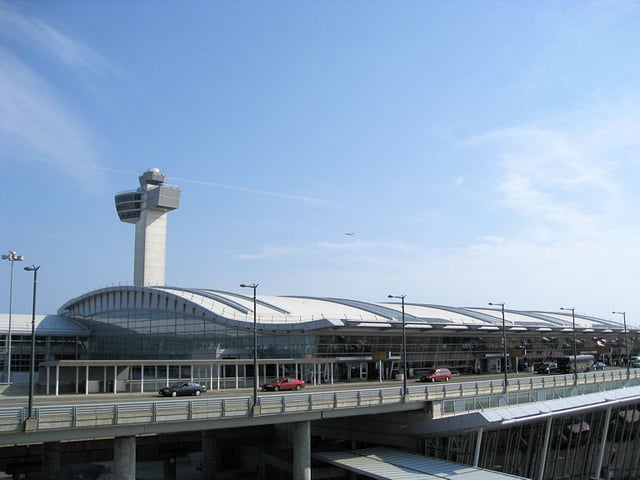
Terminal 4 replaced the former International Arrivals Building in May 2001.
Terminal 4, developed by LCOR, Inc., is managed by JFK International Air Terminal (IAT) LLC, a subsidiary of the Schiphol Group and was the first in the United States to be managed by a foreign airport operator.
Airlines providing service at Terminal 4 include SkyTeam carriers Aeromexico, Air Europa, China Airlines, Delta, Kenya Airways, KLM, and Xiamen Airlines; Star Alliance carriers Air India, Asiana Airlines, Avianca, Copa Airlines, EgyptAir, Singapore Airlines, South African Airways, and Swiss International Air Lines; and non-alliance carriers Air Serbia, Caribbean Airlines, China Southern Airlines, El Al, Emirates, Etihad Airways, Hainan Airlines, JetBlue (late night international arrivals only), Kuwait Airways, Uzbekistan Airways, Virgin Atlantic, Volaris, and WestJet.[69]
Opened in 2001 and designed by Skidmore, Owings and Merrill,[74] the 1,500,000-square-foot (140,000 m2) terminal was built at a cost of $1.4 billion and replaced JFK's old International Arrivals Building or simply IAB, which opened in 1957. The terminal was expanded in the late 2000s and early 2010s. The first phase of Delta's $1.4 billion project at the airport[75][76]—which includes nine new international gates, additional baggage space, a centralized security checkpoint (moving two checkpoints into one location just after check-in), and customs and border-security facilities—was completed on May 24, 2013.
Terminal 4 has 38 gates in two concourses: A2–A7, B18, and B22–B55 with the exclusion of B40, B50 and B52. As of 2013, Delta and the Port Authority of New York and New Jersey agreed[77] to an additional $175 million phase II expansion, which allowed Delta to construct 11 regional jet gates at Terminal 4, as well. The agreement allowed Delta to eliminate a proposed physical connection that it previously planned to build with its existing Terminal 2 and instead close T2. The work on the Delta hub was completed in January 2015, with funding primarily from $900 million in special-project bonds.[78] Delta sought funding for the regional jet expansion from the New York City Industrial Development Agency.[77]
As Terminal 4 was built during the construction of the AirTrain, the AirTrain station was built inside the terminal building. Other AirTrain stations are built across from terminal buildings. Delta has also moved much of its operations to T4, as it expands operations beyond T2, with T3 now closed. Concourse A serves as the stopping location for Asian and some European airlines, whereas Concourse B is made up of Delta flights, and a number of Asian and some European airlines.
Like Terminal 1, it is Airbus A380-compatible, and Asiana Airlines (to Seoul),[79] Emirates (to Dubai; both non-stop and one-stop flights via Milan), Etihad Airways (to Abu Dhabi),[80] and Singapore Airlines (to Singapore via Frankfurt) currently use Terminal 4 for their Airbus A380s. A variety of other airlines from across the globe as well as SkyTeam and Star Alliance utilize the terminal as well.
Terminal 5
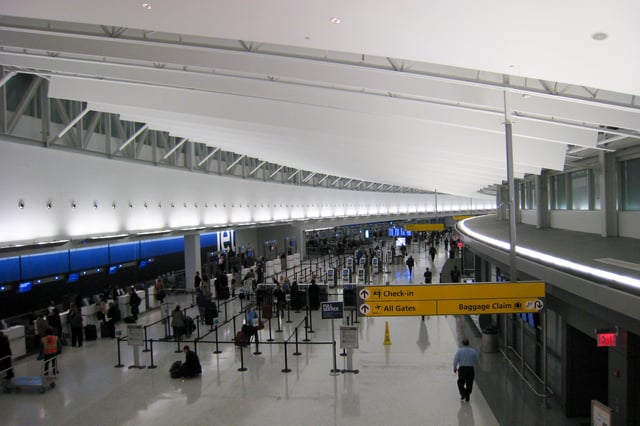
Terminal 5
Terminal 5 opened in 2008 for JetBlue, the manager and primary tenant of the building, as the base of its large JFK hub. The terminal has also been used by Hawaiian Airlines since June 2012,[81] TAP Air Portugal, Cape Air, and Irish flag carrier Aer Lingus, whose flights arriving into JFK from Shannon and Dublin have already been pre-cleared in Ireland. Aer Lingus previously used Terminal 4 prior to the introduction of pre-clearance in Ireland, moving to Terminal 5 on April 3, 2013. On November 12, 2014, JetBlue opened the International Arrivals Concourse (T5i) at the terminal.[82] TAP Air Portugal has used Terminal 5 since reinstating its JFK–Lisbon service on July 1, 2016.[83]
The terminal was redesigned by Gensler and constructed by Turner Construction, and sits behind the preserved Eero Saarinen-designed terminal originally known as the TWA Flight Center, which is now connected to the new structure and is considered part of Terminal 5.[84][85][86] The TWA Flight Center reopened as the TWA Hotel in May 2019. The active Terminal 5 building has 29 gates: 1 through 12 and 14 through 30, with gates 25 through 30 handling international flights that are not pre-cleared (gates 28–30 opened in November 2014).[87]
The terminal has a TSA Pre check point for expedited security checks and is open from 3am to 11pm. [88]
Airspace Lounge opened an airport lounge near Gate 24 in July 2013,[89] and Aer Lingus opened an airport lounge in 2015.[90] In August 2016, Fraport USA was selected by JetBlue as the concessions developer to help attract and manage concessions tenants that align with JetBlue's vision for Terminal 5.[91] During the summer of 2016, JetBlue renovated Terminal 5, completely overhauling the check-in lobby.[92]
Terminal 7
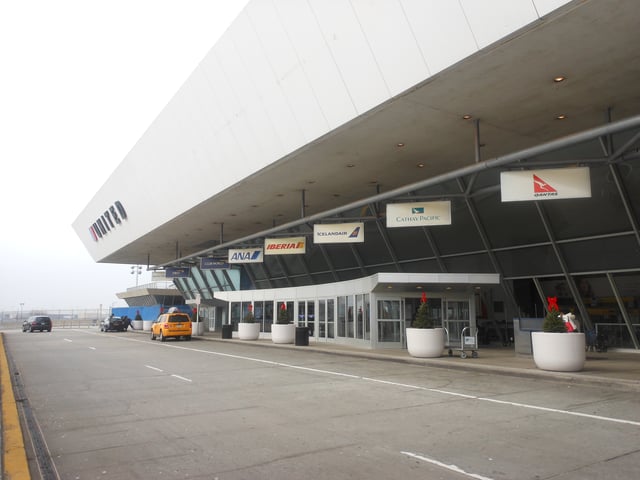
Terminal 7 – Departure Level
Terminal 7 was designed by GMW Architects[93] and built for BOAC and Air Canada in 1970. Currently operated by British Airways, it is also the only airport terminal operated on US soil by a foreign carrier, although Terminal 1 is operated by a consortium of foreign carriers serving the building.
Airlines operating out of Terminal 7 include Oneworld alliance carriers British Airways, Iberia, and Qatar Airways (AM flights),[94] Star Alliance carriers All Nippon Airways and LOT Polish Airlines, SkyTeam member Aerolíneas Argentinas, and non-alliance carriers Alaska Airlines, Eurowings, Icelandair, and Ukraine International Airlines.
Between 1989 and 1991, the terminal was renovated and expanded at a cost of $120 million.[95] The expansion was designed by William Nicholas Bodouva + Associates, Architects.[70] In 1997, the Port Authority approved British Airways' plans to renovate and expand the terminal. The $250 million project[96] was designed by Corgan Associates[97] and was completed in 2003.[98] The renovated terminal has 12 gates.[96]
In 2015, British Airways extended its lease on the terminal through 2022, with an option of a further three years.[99] BA also plans to spend $65 million to renovate the terminal.[100] Despite being operated by British Airways, a major A380 operator, Terminal 7 is not currently able to handle the aircraft type. As a result, British Airways cannot operate A380s on the lucrative London-Heathrow to New York flights.[100]
Terminal 8

Inside the security checkpoint of Terminal 8
Terminal 8 is a major Oneworld hub with American Airlines being the main Oneworld carrier. In 1999, American Airlines began an eight-year program to build the largest passenger terminal at JFK, designed by DMJM Aviation to replace both Terminal 8 and Terminal 9. The new terminal was built in four phases, which involved the construction of a new midfield concourse and demolition of old Terminals 8 and 9. It was opened in stages between 2005 and its official opening in August 2007.[101] American Airlines is the largest carrier in and manager of the terminal and is the third largest carrier at JFK. Some Oneworld airlines that operate out of Terminal 8 include Cathay Pacific, Finnair, LATAM Brasil, LATAM Chile, Qantas, Qatar Airways, and Royal Jordanian Airlines, as well as Star Alliance carrier Ethiopian Airlines. British Airways and Iberia plan to move into Terminal 8 by the end of 2022 following its renovation and expansion.[102]
The terminal is twice the size of Madison Square Garden. It offers dozens of retail and food outlets, 84 ticket counters, 44 self-service kiosks, 10 security checkpoint lanes and a U.S. Customs and Border Protection facility that can process more than 1,600 people an hour. Terminal 8 has an annual capacity of 12.8M passengers.[103] It has two American Airlines Admirals Clubs and a Flagship Lounge for premium class passengers.
Terminal 8 has 29 gates: 12 gates in Concourse B (1–8, 10, 12, 14 and 16) and 17 gates in Concourse C (31–47).[104] Gate 31 is further subdivided into 5 regional service gates for small jets, 31A–31E. Gate 32 is subdivided into 4 regional service gates for small jets, 32F–32I. The total number of jetbridges is, therefore, 36. Passenger access to Concourse C is by an underground tunnel that includes moving walkways.
Former terminals
JFK Airport was originally built with ten terminals, compared to the six it has today. Ten terminals remained until the late 1990s, then nine remained until the early 2000s, followed by eight until 2011 and seven until May 2013.
Eastern Air Lines terminal
This terminal opened in 1959 and was demolished in 1995 after the collapse of Eastern Air Lines in 1991. The terminal was on the site of today's Terminal 1.[105]
Terminal 3 (Worldport)
Terminal 3 was built as the Worldport in 1960 for Pan American; it expanded after the introduction of the 747 in 1970. After Pan Am's demise in 1991 Delta Air Lines took over ownership of the terminal and was its only occupant until its closure in 2013. It had a connector to Terminal 2, Delta's other terminal. Terminal 3 had 16 Jetway equipped gates: 1–10, 12, 14–18 with two hardstand gates (Gate 11) and a helipad on Taxiway KK.
A $1.2 billion project was completed in 2013, under which Terminal 4 was expanded and with Delta subsequently moving its T3 operations to T4.
On May 23, 2013, the final departure from the terminal, Delta Air Lines Flight 268, a Boeing 747-400 to Tel Aviv Ben Gurion Airport, departed from Gate 6 at 11:25 p.m. local time. The terminal ceased operations on May 24, 2013, 53 years to the day from when it opened on May 24, 1960.[106] Demolition began soon thereafter and was completed by Summer 2014. The site where Terminal 3 used to stand is now used for aircraft parking by Delta Air Lines.
Terminal 6 (Sundrome)
Terminal 6 had 14 gates. Designed by I. M. Pei, it was built in 1970 as the National Airlines Sundrome. Later, Trans World Airlines used it. In 2000, JetBlue Airways began service from Terminal 6, later opening a temporary complex in 2006 that increased its capacity by adding seven gates. After JetBlue vacated the terminal, it was demolished.[111] The international arrivals annex of Terminal 5 now uses a portion of the site, and the rest of the site is used for aircraft parking by both JetBlue and British Airways (which operates from nearby Terminal 7).
Old Terminal 8 and 9
The original Terminal 8 opened in 1960; its stained-glass façade was the largest in existence at the time. It was always used by American Airlines and in later years it was used by other Oneworld airlines that did not use Terminal 7.
Terminal 9 opened in 1959 and was used by United Airlines[16] and Delta Air Lines.[28] Delta moved to Terminal 2 when they acquired Northeast Airlines.[112] Braniff International moved from Terminal 2 to Terminal 9 in 1973, and operated in Terminal 9 until its bankruptcy in 1982.[113] United used Terminal 9 from its opening in 1959 until it vacated the terminal in 1991 and became a tenant at British Airways' Terminal 7. Terminal 9 then became the home of American Airlines' domestic operations and American Eagle flights for the remainder of its life. The terminals were demolished in the early-to-mid-2000s and replaced with a new Terminal 8.[101]
Tower Air terminal
The Tower Air terminal, unlike other terminals at JFK airport, sat outside the Central Terminals area in Building 213 in Cargo Area A. Originally used by Pan Am until the expansion of the Worldport (later Terminal 3), it was later used by Tower Air and TWA shuttle until the airline was acquired by American Airlines in 2001. Building 213 has not been used since 2000. It is located next to the Delta Air Lines employees' parking lot number 7, which was once the Tower Air terminal parking lot.
TWA Flight Center
TWA Flight Center opened in 1962. It was designed for Trans World Airlines by Eero Saarinen. The terminal was one of the first with many of the features airport terminals have today. The New York landmarks commission voted the terminal as a landmark in 1994[114] and In 2005, the National Park Service listed it on the National Register of Historic Places.[115] In May 2019, when restoration was complete, the terminal was reopened as TWA Hotel.[116][117]
Infrastructure
Runways
| Number | Length | Width | ILS | Notes |
|---|---|---|---|---|
| 13R/31L | 14,511 feet (4,423 m) | 200 feet (61 m) | Cat. I (31L) | Third-longest commercial runway in North America (the longest is a 16,000-foot (4,900 m) runway at Denver International Airport. Second is a 14,512-foot (4,423 m) runway at Las Vegas International.) Adjacent to Terminals 1, 2, and 3. Handled approximately one half of the airport's scheduled departures. It was a backup runway for space shuttle missions.[120] It was closed on March 1, 2010 for four months. The reconstruction of the runway widened it from 150 to 200 feet (46 to 61 m) with a concrete base instead of asphalt. It reopened on June 29, 2010.[121] |
| 4R/22L | 8,400 feet (2,560 m) | 200 feet (61 m) | Cat. III (both directions) | Equipped at both ends with Approach Lighting Systems (ALS) with sequenced flashers, and touchdown zone (TDZ) lighting. The first Engineered Materials Arresting System (EMAS) in North America was installed at the northeast end of the runway in 1996. The bed consists of cellular cement material, which can safely decelerate and stop an aircraft that overruns the runway. The arrestor bed concept was originated and developed by the Port Authority and installed at JFK Airport as a joint research and development project with the FAA and industry. |
| 4L/22R | 12,079 feet (3,682 m) | 200 feet (61 m) | Cat. I (both directions) | Adjacent to Terminals 4 and 5. Both ends allow instrument landings down to three-quarters of a mile's visibility. Takeoffs can be conducted with one-eighth of a mile's visibility. It closed on June 1, 2015 for almost 4 months as part of a major runway modernization project that replaced the asphalt base with a concrete base and widened the runway from 150 to 200 feet (46 to 61 m). It reopened on September 28, 2015.[122] |
| 13L/31R | 10,000 feet (3,048 m) | 150 feet (46 m) | Cat. II (13L); Cat. I (31R) | Adjacent to Terminals 5 and 7. Equipped at both ends with ILS and ALS systems. Runway 13L has two additional visual aids for landing aircraft, a Precision Approach Path Indicator (PAPI) and a Lead-In Lighting System (LDIN). The ILS on 13L, along with TDZ lighting, allows landings down to half a mile's visibility. Takeoffs can be made with visibility of one-eighth of a mile. It closed on April 1, 2019 for almost 8 months as part of a major runway modernization project that replaces the asphalt base with a concrete base and widens the runway from 150 to 200 feet (46 to 61 m). The runway is expected to reopen on November 16, 2019.[123][124] |
Operational facilities
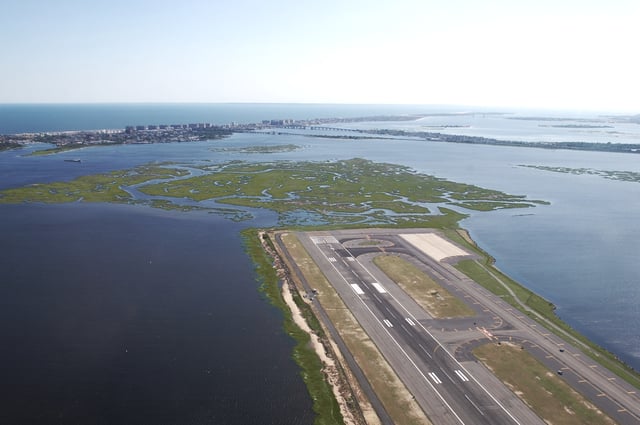
Looking at runway 4L/22R and out to sea.

JFK airport- February 2017
JFK has over 25 miles (40 km) of taxiways to move aircraft in and around the airfield. The standard width of these taxiways is 75 feet (23 m), with 25 feet (7.6 m) heavy-duty shoulders and 25-foot (7.6 m) erosion control pavements on each side. The taxiways have centerline lights and are generally of asphalt concrete composition 15 to 18 inches (380 to 460 mm) thick. An illuminated sign system provides directional information for taxiing aircraft.
The Air Traffic Control Tower, designed by Pei Cobb Freed & Partners and constructed on the ramp-side of Terminal 4, began full FAA operations in October 1994.[125] An Airport Surface Detection Equipment (ASDE) radar unit sits atop the tower. A gas-fired electric cogeneration plant generates electricity for the airport, with an output of about 90 megawatts (120,000 hp). It uses thermal energy from the capture of waste heat to heat and cool all of the passenger terminals and other facilities in the central terminal area.[126] At the time of its completion, the JFK tower, at 320 feet (98 m), was the world's tallest control tower.[125] It was subsequently displaced from that position by towers at other airports in both the United States and overseas, including those at Hartsfield–Jackson Atlanta International Airport, currently the tallest tower at any U.S. airport, at 398 feet (121 m) and at KLIA2 in Kuala Lumpur, Malaysia, currently the world's tallest control tower at 438 feet (134 m).[127]
Aircraft service facilities include seven aircraft hangars, an engine overhaul building, a 32-million-US-gallon (120,000 m3) aircraft fuel storage facility and a truck garage.
In the last few years, improvements have been made to terminals, roadways and inter-terminal transportation.[128]
Other facilities
North American Airlines had its headquarters in Building 141 along Federal Circle, on the airport property.[129] North American Airlines was one of the building's tenants; the building does have Servisair and VOA as tenants and Port Authority storage.[130] Building 141 was originally a Port Authority of New York and New Jersey (PANYNJ) administration building.[131] In the 1990s it served as the PANYNJ police headquarters.[132] In 2000 an $800,000, 5,000-square-foot (460 m2) annex of the building opened to serve students of Aviation High School in Long Island City.[131] In 2003 Building 141 was dedicated in honor of Morris Sloane, a PANYNJ aviation employee.[133]
Hangar 17, originally occupied by Pan American and later Tower Air, found a new and important role housing artifacts from 9/11 that eventually made their way to the 9/11 Museum at Ground Zero.
Servisair has its offices in Building 86.[130]
CAL Cargo Airlines has its offices in Building 23.[134]
Currently Nippon Cargo Airlines has its New York City branch in Cargo Building 66.[135]
The Port Authority of New York and New Jersey Police Department (PAPD) provides law enforcement, fire rescue and emergency medical services to the airport. Its JFK Command is based in Building 269.
PANYNJ operations and administrative offices are located in Building 14.
Three chapels, including Our Lady of the Skies Chapel, provide for the religious needs of airline passengers.[140]
Sheltair is the current FBO on the field serving General Aviation traffic. The company became the first privately operated FBO at JFK Airport in its 65-year history when it opened on May 21, 2012.[141]In January 2017, the Ark at JFK Airport, a luxury terminal for pets, opened at a cost of $65 million. Ark was built ostensibly so that people who were transporting pets and other animals would be able to provide luxurious accommodations for these animals. At the time, it was supposed to be the only such facility in the U.S.[142] However, in January 2018, Ark's owner sued the Port Authority for violating a clause that would have given Ark the exclusive rights to inspect all animals who arrive at JFK from other countries. In the lawsuit, the owner stated that Ark had incurred large operational losses because many animals were instead being transported to a United States Department of Agriculture facility in Newburgh.[143]
Information services
Kennedy Airport, along with the other Port Authority airports (LaGuardia and Newark), uses a uniform style of signage throughout the airport properties. Yellow signs direct passengers to airline gates, ticketing and other flight services; green signs direct passengers to ground transportation services and black signs lead to restrooms, telephones and other passenger amenities. In addition, the Port Authority operates "Welcome Centers" and taxi dispatch booths in each airline terminal, where staff provide customers with information on taxis, limousines, other ground transportation and hotels.
New York City traffic reporter Bernie Wagenblast provides the voice for the airport's radio stations and the messages heard on board AirTrain JFK and in its stations.[145]
Airport hotels
There are several hotels adjacent to JFK Airport, including the Courtyard by Marriott and the Crowne Plaza. The former Ramada Plaza JFK Hotel is Building 144,[146][147] and it was the only on-site hotel at JFK Airport.[148] It was previously a part of Forte Hotels and previously the Travelodge New York JFK.[149] Due to its role in housing friends and relatives of aircraft crash victims in the 1990s and 2000s, the hotel became known as the "Heartbreak Hotel".[150][151] In 2009 the PANYNJ stated in its preliminary 2010 budget that it was closing the hotel due to "declining aviation activity and a need for substantial renovation" and that it expected to save $1 million per month.[152] The hotel closed on December 1, 2009. Almost 200 employees lost their jobs. As of 2009, the Port Authority hoped to build a new hotel on the airport property.[153]
On July 27, 2015, Governor Andrew Cuomo announced in a press conference that the TWA Flight Center building would be used by the TWA Hotel, a 505-room hotel with 40,000 square feet of conference, event, or meeting space. The new hotel is estimated to cost $265 million and it opened in 2019. The public will be able to visit the hotel's 10,000-square-foot observation deck.[154] Groundbreaking for the hotel occurred on December 15, 2016,[155] and it opened on May 15, 2019.[155]
Airlines and destinations
Passenger
| Airlines | Destinations | Refs |
|---|---|---|
| Aer Lingus | Dublin Seasonal: Shannon | [156] |
| Aeroflot | Moscow–Sheremetyevo | [157] |
| Aerolíneas Argentinas | Buenos Aires–Ezeiza | [158] |
| Aeroméxico | Mexico City | [159] |
| Aeroméxico Connect | Monterrey | [159] |
| Air China | Beijing–Capital | [160] |
| Air Europa | Madrid | [161] |
| Air France | Paris–Charles de Gaulle, Paris–Orly | [162] |
| Air India | Delhi, Mumbai (resumes October 21, 2019)[163] | |
| Air Italy | Milan–Malpensa | [164] |
| Air Serbia | Belgrade | [165] |
| Alaska Airlines | Los Angeles, Portland (OR), San Francisco, San Jose (CA), Seattle/Tacoma Seasonal: Palm Springs | [166] |
| Alitalia | Milan–Malpensa, Rome–Fiumicino | [167] |
| All Nippon Airways | Tokyo–Haneda, Tokyo–Narita | [168] |
| American Airlines | Antigua, Austin, Barcelona, Bermuda, Boston, Buenos Aires–Ezeiza, Cancún, Charlotte, Chicago–O'Hare, Dallas/Fort Worth, Georgetown–Cheddi Jagan (begins December 18, 2019),[169] Las Vegas, Liberia (CR) (begins December 21, 2019),[170] London–Heathrow, Los Angeles, Madrid, Miami, Milan–Malpensa, Montego Bay (begins November 21, 2019),[170] Paris–Charles de Gaulle, Phoenix–Sky Harbor, St. Thomas, San Antonio, San Diego (resumes November 2, 2019),[171] San Francisco, San José de Costa Rica (begins November 21, 2019),[170] São Paulo–Guarulhos, Seattle/Tacoma (resumes November 2, 2019)[171] Seasonal: Eagle/Vail, Punta Cana, Rio de Janeiro–Galeão, Rome–Fiumicino, St. Kitts, St. Maarten | [172] |
| American Eagle | Baltimore, Cincinnati, Cleveland, Columbus–Glenn, Indianapolis, Montréal–Trudeau, Nashville, Norfolk, Philadelphia (resumes November 20, 2019),[173] Pittsburgh, Raleigh/Durham, Richmond (begins November 21, 2019),[174] Toronto–Pearson, Washington–National[171] | [172] |
| Asiana Airlines | Seoul–Incheon | [175] |
| Austrian Airlines | Vienna | [176] |
| Avianca | Bogotá, Cali, Medellín–JMC | [177] |
| Avianca Costa Rica | San José de Costa Rica, San Salvador | [177] |
| Avianca El Salvador | San Pedro Sula, San Salvador | [177] |
| Azerbaijan Airlines | Baku | [178] |
| British Airways | London–Citya, London–Gatwick, London–Heathrow | [179] |
| Brussels Airlines | Brussels | [180] |
| Cape Air | Hyannis, Martha's Vineyard, Nantucket | [181] |
| Caribbean Airlines | Georgetown–Cheddi Jagan, Kingston–Norman Manley, Montego Bay, Port of Spain, St. Vincent–Argyle, Tobago | [182] |
| Cathay Pacific | Hong Kong, Vancouver (ends March 28, 2020)[183] | [184] |
| Cayman Airways | Grand Cayman | [185] |
| China Airlines | Taipei–Taoyuan | [186] |
| China Eastern Airlines | Shanghai–Pudong | [187] |
| China Southern Airlines | Guangzhou, Wuhan[188] | [189] |
| Copa Airlines | Panama City | [190] |
| Delta Air Lines | Accra, Amsterdam, Antigua, Aruba, Atlanta, Austin, Barcelona, Bermuda, Bogotá (resumes December 21, 2019),[191] Boston, Brussels, Cancún, Charlotte, Charleston (SC), Dakar–Diass, Dallas/Fort Worth, Denver, Detroit, Dublin, Edinburgh, Fort Lauderdale, Fort Myers, Frankfurt, Houston–Intercontinental (resumes October 27, 2019),[192] Jacksonville (FL), Kingston–Norman Manley, Lagos, Las Vegas, Lisbon, London–Heathrow, Los Angeles, Madrid, Mexico City, Miami, Milan–Malpensa, Minneapolis/St. Paul, Montego Bay, Mumbai (begins December 22, 2019),[193] Nassau, New Orleans, Orlando, Palm Beach, Paris–Charles de Gaulle, Philadelphia, Phoenix–Sky Harbor, Portland (OR), Punta Cana, Rome–Fiumicino, Salt Lake City, San Antonio, San Diego, San Francisco, San Jose (CA), San Juan, Santiago de los Caballeros, Santo Domingo–Las Américas, São Paulo–Guarulhos, Seattle/Tacoma, St. Maarten, Tampa, Tel Aviv, Washington–National, West Palm Beach, Zürich Seasonal: Athens, Berlin–Tegel, Copenhagen, Glasgow, Grenada, Honolulu, Jackson Hole, Málaga, Nice, Ponta Delgada, Prague, Providenciales, Reykjavík–Keflavík, Rio de Janeiro–Galeão, San José del Cabo, Shannon, St. Kitts, St. Thomas, Vancouver, Venice | [194] |
| Delta Connection | Baltimore, Boston, Buffalo, Burlington (VT), Charleston (SC), Charlotte, Chicago–O'Hare, Cincinnati, Cleveland, Columbus–Glenn, Dallas/Fort Worth, Detroit, Indianapolis, Jacksonville (FL), Montréal–Trudeau, Nashville, Norfolk, Pittsburgh, Portland (ME), Raleigh/Durham, Richmond, Rochester (NY), Savannah, Syracuse, Toronto–Pearson, Washington–Dulles, Washington–National Seasonal: Sarasota | |
| EgyptAir | Cairo | [195] |
| El Al | Tel Aviv | [196] |
| Emirates | Dubai–International, Milan–Malpensa | [197] |
| Ethiopian Airlines | Abidjan, Addis Ababa | [198] |
| Etihad Airways | Abu Dhabi | [199] |
| Eurowings | Seasonal: Düsseldorf | [200] |
| EVA Air | Taipei–Taoyuan | [201] |
| Finnair | Helsinki | [202] |
| Hainan Airlines | Chengdu, Chongqing | [203] |
| Hawaiian Airlines | Honolulu | [204] |
| Iberia | Madrid | [205] |
| Icelandair | Reykjavík–Keflavík | [206] |
| Interjet | Mexico City | [207] |
| Japan Airlines | Tokyo–Haneda, Tokyo–Narita | [208] |
| JetBlue | Aguadilla, Albuquerque, Antigua, Aruba, Atlanta, Austin, Barbados, Bermuda, Boston, Buffalo, Burbank, Burlington (VT), Cancún, Cartagena, Charleston (SC), Charlotte (ends October 27, 2019),[209] Curaçao, Denver, Fort Lauderdale, Fort Myers, Georgetown-Cheddi Jagan (begins April 2, 2020),[210] Grand Cayman, Grenada, Guayaquil (begins December 5, 2019),[211] Havana, Houston–Hobby (ends October 26, 2019), Houston–Intercontinental (begins October 27, 2019),[212] Jacksonville (FL), Kingston–Norman Manley, La Romana, Las Vegas, Liberia (CR), Long Beach, Los Angeles, Mexico City, Montego Bay, Nassau, New Orleans, Oakland, Ontario, Orlando, Palm Beach, Phoenix–Sky Harbor, Pointe-à-Pitre (begins February 1, 2020),[213] Ponce, Port-au-Prince, Port of Spain, Portland (OR), Providenciales, Puerto Plata, Punta Cana, Raleigh/Durham, Reno/Tahoe, Rochester (NY), Sacramento, St. Lucia–Hewanorra, St. Maarten, Salt Lake City, San Diego, San Francisco, San José de Costa Rica (begins November 1, 2019),[214] San Jose (CA), San Juan, Santiago de los Caballeros, Santo Domingo–Las Américas, Sarasota, Savannah, Seattle/Tacoma, Syracuse, Tampa, West Palm Beach, Worcester Seasonal: Hyannis, Martha's Vineyard, Nantucket, Palm Springs, Portland (ME) | [215] |
| Kenya Airways | Nairobi–Jomo Kenyatta | [216] |
| KLM | Amsterdam | [217] |
| Korean Air | Seoul–Incheon | [218] |
| Kuwait Airways | Kuwait | [219] |
| LATAM Brasil | São Paulo–Guarulhos | [220] |
| LATAM Chile | Lima, Santiago de Chile | [220] |
| LATAM Ecuador | Guayaquil | [220] |
| Level | Barcelona | [221] |
| LOT Polish Airlines | Budapest, Kraków (resumes May 3, 2020),[222] Warsaw–Chopin | [223] |
| Lufthansa | Frankfurt, Munich | [224] |
| Norwegian Air Shuttle | Amsterdam, London–Gatwick, Madrid, Oslo–Gardermoen, Paris–Charles de Gaulle Seasonal: Athens, Copenhagen, Stockholm–Arlanda | [225] |
| Philippine Airlines | Manila | [226] |
| Qantas | Sydney[227]b | [228] |
| Qatar Airways | Doha | [229] |
| Royal Air Maroc | Casablanca | [230] |
| Royal Jordanian | Amman–Queen Alia | [231] |
| Saudia | Jeddah, Riyadh Hajj: Medina | [232] |
| Singapore Airlines | Frankfurt, Singapore | [233] |
| South African Airways | Johannesburg–O. R. Tambo | [234] |
| Swiss International Air Lines | Geneva, Zürich | [235] |
| TAP Air Portugal | Lisbon | [236] |
| Turkish Airlines | Istanbul | [237] |
| Ukraine International Airlines | Kiev–Boryspil | [238] |
| Uzbekistan Airways | Tashkent | [239] |
| Virgin Atlantic | London–Gatwick (resumes May 21, 2020),[240][241] London–Heathrow, Manchester (UK) | [242] |
| VivaAerobus | Mexico City | [243] |
| Volaris | Guadalajara | [244] |
| Volaris Costa Rica | San José de Costa Rica, San Salvador | [245] |
| WestJet | Calgary | [246] |
| XiamenAir | Fuzhou | [247] |
Notes
^a Flights from London–City to New York–JFK have a stopover in Shannon for refueling due to weight restrictions in LCY. However, British Airways does not carry local traffic between Shannon and New York. The flight from New York to London is non-stop. This flight is flown by an Airbus A318.
^b Qantas flies from New York to Sydney as QF12 with a stop-over in Los Angeles, where passengers will have the option to connect onto the airline's flights to Brisbane and Melbourne. Although the same flight number continues to Sydney there is an aircraft swap at Los Angeles from a 787 Dreamliner to an Airbus A380 (the 787 continues to Brisbane). Furthermore, the airline does not have eighth freedom rights to solely transport passengers between New York and Los Angeles due to regulations by the United States government.[248]
Cargo
When ranked by the value of shipments passing through it, JFK is the number three freight gateway in the United States (after the Port of Los Angeles and the Port of New York and New Jersey), and the number one international air freight gateway in the United States.[4] Almost 21% of all U.S. international air freight by value and 9.6% by tonnage moved through JFK in 2008.[249]
The JFK air cargo complex is a Foreign Trade Zone, which legally lies outside the customs area of the United States.[250] JFK is a major hub for air cargo between the United States and Europe. London, Brussels and Frankfurt are JFK's three top trade routes.[251] The European airports are mostly a link in a global supply chain, however. The top destination markets for cargo flying out of JFK in 2003 were Tokyo, Seoul and London. Similarly, the top origin markets for imports at JFK were Seoul, Hong Kong, Taipei and London.[251]
Nearly 100 cargo air carriers operate out of JFK,[251] among them: Air China Cargo, ABX Air, Asiana, Atlas Air, CAL Cargo Air Lines, Cargolux, Cathay Pacific Cargo, China Airlines, EVA Air, Emirates SkyCargo, Nippon Cargo Airlines, FedEx Express, DHL Air UK, Kalitta Air, Korean Air, Lufthansa Cargo, UPS Airlines, Southern Air and, formerly, World Airways. Top 5 carriers together transported 33.1% of all revenue freight in 2005: American Airlines (10.9% of the total), FedEx Express (8.8%), Lufthansa Cargo (5.2%), Korean Air Cargo (4.9%), China Airlines (3.8%).[252]
Most cargo and maintenance facilities at JFK are located north and west of the main terminal area. DHL, FedEx Express, Japan Airlines, Lufthansa, Nippon Cargo Airlines and United Airlines have cargo facilities at JFK.[251][253] In 2000, Korean Air Cargo opened a new $102 million cargo terminal at JFK with total floor area of 81,124 square feet (7,536.7 m2) and capability of handling 200,000 tons annually. In 2007, American Airlines opened a new priority parcel service facility at their Terminal 8, featuring 30-minute drop-offs and pick-ups for priority parcel shipments within the US.[254]
| Airlines | Destinations |
|---|---|
| ACE Belgium Freighters | Liège, Tel Aviv |
| Air China Cargo[255] | Anchorage, Beijing–Capital, Dallas/Fort Worth, Shanghai–Pudong |
| Asiana Airlines Cargo[256] | Anchorage, Brussels, Miami, Seoul–Incheon |
| ASL Airlines Belgium[257] | Liège |
| Atlas Air | Anchorage, Hangzhou |
| CAL Cargo Air Lines | Liège, Tel Aviv |
| Cargolux[258] | Chicago–O'Hare, Guadalajara, Houston–Intercontinental, Los Angeles, Luxembourg, Mexico City, Toulouse |
| Cargolux Italia | Milan–Malpensa |
| Cathay Pacific Cargo[259] | Anchorage, Calgary, Chicago–O'Hare, Columbus–Rickenbacker, Hong Kong, Portland (OR), Toronto–Pearson |
| China Airlines Cargo[260] | Anchorage, Taipei–Taoyuan |
| DHL Aviation | Anchorage, Chicago–O'Hare, Cincinnati, East Midlands, Leipzig/Halle |
| Emirates SkyCargo[261][262] | Chicago–O'Hare, Dubai–Al Maktoum, Maastricht |
| FedEx Express[263] | Indianapolis, Memphis, Washington–Dulles |
| Kalitta Air | Amsterdam |
| Korean Air Cargo[264] | Anchorage, Miami, Seoul–Incheon, Shanghai–Pudong, Toronto–Pearson |
| Lufthansa Cargo[265] | Atlanta, Frankfurt, Mexico City |
| Nippon Cargo Airlines[266] | Anchorage, Chicago–O'Hare, Tokyo–Narita |
| Qantas Freight[267][268] | Anchorage, Chongqing, Shanghai–Pudong |
| Qatar Airways Cargo[269] | Doha, Halifax, Zaragoza |
| Royal Jordanian Cargo | Amman–Queen Alia, Maastricht |
| Saudia Cargo[270] | Jeddah |
| SkyLink Express | Hamilton (ON) |
| Turkish Airlines Cargo[271] | Aguadilla, Bogota, Istanbul–Atatürk, Toronto–Pearson, Zaragoza |
| UPS Airlines | Chicago/Rockford, Louisville, Orlando, Philadelphia Seasonal: Hartford |
Statistics
In 2015, JFK Airport handled 56,827,154 revenue passengers, which was a 2.3% increase over 2014. 2013 marked the first time JFK Airport handled more than 50 million passengers in one year.[272]
The airport contributes about $30.1 billion in economic activity to the New York City region, generating 229,000 jobs and about $9.8 billion in wages and salaries. About 35,000 people are employed at the airport.[273]
Nearly 100 airlines from over 50 countries operate regularly scheduled flights from JFK Airport. The New York-JFK to London–Heathrow route is the leading U.S. international airport pair with over 2.6 million passengers in 2011. Domestic travel also accounts for a large share of airport traffic, particularly transcontinental and Florida service.[274]
Top destinations
| Rank | Airport | Passengers | Carriers |
|---|---|---|---|
| 1 | 1,726,400 | Alaska, American, Delta, JetBlue | |
| 2 | 1,007,000 | Alaska, American, Delta, JetBlue | |
| 3 | 763,000 | American, Delta, JetBlue | |
| 4 | 593,000 | Delta, JetBlue | |
| 5 | 588,000 | Alaska, American, Delta, JetBlue | |
| 6 | 553,000 | American, Delta | |
| 7 | 525,000 | Alaska, American, Delta, JetBlue | |
| 8 | 480,000 | Delta, JetBlue | |
| 9 | 469,000 | Delta, JetBlue | |
| 10 | 413,830 | American, Delta, JetBlue |
| Rank | Airport | Passengers 2017–18 | Change 2017-18 | Carriers |
|---|---|---|---|---|
| 1 | 2,949,407 | American Airlines, British Airways, Delta, Virgin Atlantic | ||
| 2 | 1,555,957 | Air France, American, Delta, Norwegian Air Shuttle, XL Airways France | ||
| 3 | 979,126 | AeroMexico, Delta, InterJet, JetBlue, Volaris | ||
| 4 | 930,763 | Delta, JetBlue | ||
| 5 | 919,737 | Delta, JetBlue | ||
| 6 | 863,311 | Delta, KLM, Norwegian | ||
| 7 | 820,572 | Air Italy, American, Alitalia, Delta, Emirates | ||
| 8 | 791,978 | Air Europa, American, Delta, Iberia, Norwegian Air Shuttle | ||
| 9 | 796,115 | Delta, Lufthansa, Singapore Airlines | ||
| 10 | 755,915 | Asiana, Korean | ||
| 11 | 741,385 | AeroMexico, American, Delta, InterJet, JetBlue | ||
| 12 | 725,152 | Alitalia, American, Delta |
Airline market share
| Rank | Airline | Passengers | Share |
|---|---|---|---|
| 1 | Delta Air Lines | 17,363,204 | 28.3% |
| 2 | JetBlue | 14,365,156 | 23.3% |
| 3 | American Airlines | 6,908,445 | 11.3% |
| 4 | British Airways | 1,444,149 | 2.3% |
| 5 | Alaska Airlines | 1,408,024 | 2.3% |
| 6 | Norwegian Air Shuttle | 1,396,433 | 2.3% |
| 7 | Virgin Atlantic | 1,115,915 | 1.8% |
| 8 | Air France | 1,110,638 | 1.8% |
| 9 | Emirates | 894,031 | 1.5% |
| 10 | Lufthansa | 634,104 | 1.0% |
| 11 | Alitalia | 617,581 | 1.0% |
| 12 | Cathay Pacific | 607,394 | 1.0% |
| 13 | Aeroflot | 549,052 | 0.9% |
| 14 | Turkish Airlines | 537,844 | 0.9% |
| 15 | Aeromexico | 514,825 | 0.8% |
| 16 | Avianca | 495,678 | 0.8% |
| 17 | Korean Air | 493,011 | 0.8% |
| 18 | Caribbean Airlines | 485,915 | 0.8% |
| 19 | Aer Lingus | 483,075 | 0.8% |
| 20 | KLM | 466,073 | 0.7% |
Ground transportation
Rail
JFK Airport is connected to the New York City Subway and Long Island Rail Road by AirTrain JFK. It stops at all terminals, parking lots, hotel shuttle areas, car rental lots, the Jamaica LIRR station, Howard Beach-JFK Airport subway station on the IND Rockaway Line (A train) and Sutphin Boulevard–Archer Avenue–JFK Airport subway station on the Archer Avenue Line (E, J, and Z trains).[278]
Shuttle bus
NYC Airporter is the only permitted and official operator of express airport bus service for the New York City Department of Transportation and Port Authority of New York and New Jersey (the airports' operator).
Bus
Several city bus lines link JFK to the New York City Subway and Long Island Rail Road, including the Q3, Q6, Q7, Q10, B15, with free transfers provided for subway connections. The B15, Q3 and Q10 buses all serve the Central Terminal Area via a dedicated bus stop at the former Terminal 6 (connection to other terminals via AirTrain JFK, with a direct walkway provided to Terminal 5), while the Q6 serves only eastern Cargo Area D and the USPS Airport Mail facility and the Q7 serves only Cargo Area C. There are also many private bus lines operating express buses to Manhattan, the Hudson Valley and Long Island.
The Port Authority provides free shuttle-bus service between the Federal Circle AirTrain station and the airport's cargo areas, as well as within the long-term and Port Authority-operated employee parking lots. These buses are operated by Servisair under contract.
Two Taiwanese airlines provide private bus services for their customers to New Jersey and the Philadelphia area:
China Airlines: Fort Lee, Parsippany, Jersey City, Cherry Hill, Downtown Philadelphia, and South Philadelphia[279]
EVA Air: Jersey City, Piscataway, Fort Lee, East Hanover, Cherry Hill, South Philadelphia, and Cheltenham[280]
Taxi
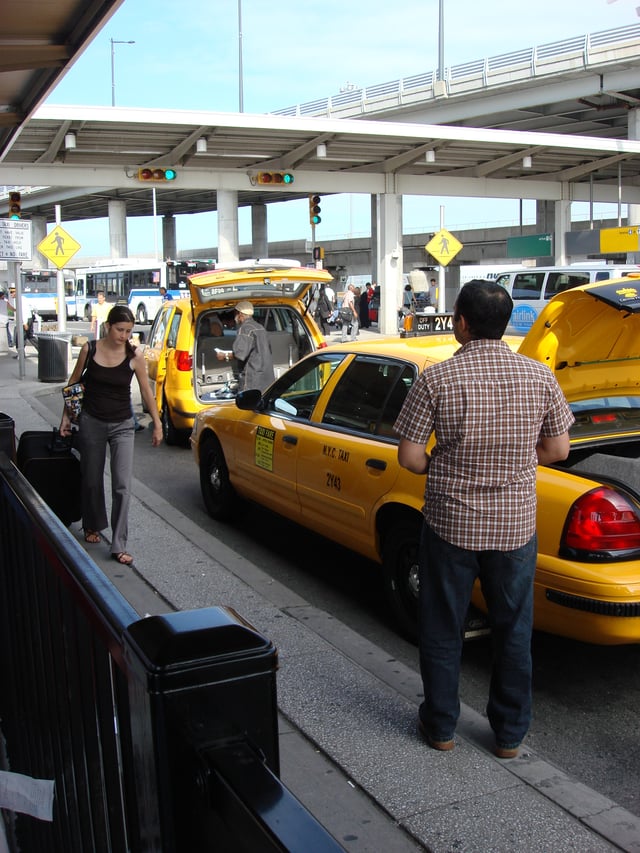
A taxi at JFK Airport
New York City's yellow cabs, licensed by the New York City Taxi & Limousine Commission, offer a flat-rate service of $52 from JFK Airport to Manhattan, excluding tips and tolls. Since November 30, 2006, this flat-rate fare (excluding tips and tolls) applies to travel from Manhattan to JFK as well. Depending on the time of day, taxi travel from JFK to Midtown Manhattan can be as quick as 35 minutes or as long as 90 minutes. Door-to-door car service is another popular transportation option.
Car
JFK Airport is located in southern Queens on the Van Wyck Expressway (I-678), which can be accessed from the Belt Parkway, the Grand Central Parkway and Queens Boulevard. A ring road connects the airport terminals to the Belt Parkway and the Van Wyck Expressway. The airport offers customers over 17,000 parking spaces, included in multi-level parking garages, surface spaces in the Central Terminal Area, a long-term parking lot and valet parking.[273] Tesla, Inc. has a Supercharger (fast vehicle charging station) at the airport.[281] There are also private off-site parking operators near the airport.
Van Wyck Expressway twists through the terminal nucleus and turns into the JFK Expressway. This four-lane expressway allows for more convenient access to the airport for Long Island users via the westbound Belt Parkway. Because it lies almost entirely within Kennedy Airport, the JFK Expressway was constructed and is maintained by the Port Authority. The expressway was built as part of an ongoing, multi-billion-dollar overhaul of Kennedy Airport that began in the late 1980s. It was designed to relieve up to 30 percent of the traffic volume from the Van Wyck Expressway.[282] Approximately six major rental car companies serve JFK Airport, with rental locations on and off the airport.
Helicopter
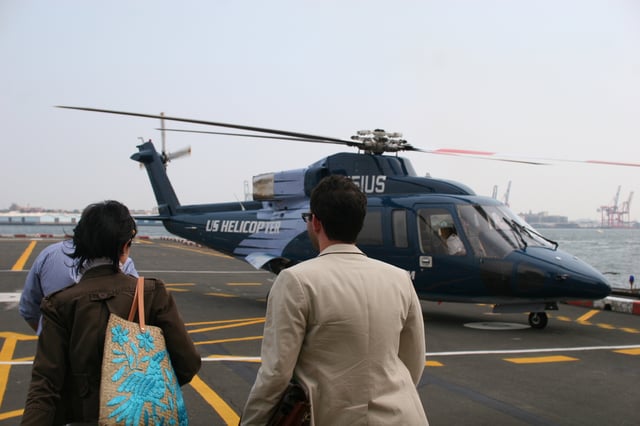
US Helicopter departing from the Downtown Manhattan Heliport
US Helicopter operated regularly scheduled flights every hour between Terminal 3 and the East 34th Street Heliport. Passengers traveling by helicopter to the airport passed through a security checkpoint at the heliport, not at JFK. On May 14, 2007, US Helicopter moved its operations from Terminal 9 to Terminal 3.[283] US Helicopter temporarily suspended operations on September 25, 2009 due to financial difficulties.[284]
New York Airways provided helicopter service from JFK to other area airports and heliports from 1955 to 1979 and Pan American World Airways continued Manhattan helicopter service during the 1980s in order to feed its JFK flights. During the 1970s, New York Helicopter offered JFK flights from the top of the then-Pan Am Building in midtown Manhattan, but this service was cancelled after a major accident in 1977.[285]
Accidents and incidents
[[INLINE_IMAGE|//upload.wikimedia.org/wikipedia/commons/thumb/2/24/Wikinews-logo.svg/16px-Wikinews-logo.svg.png|//upload.wikimedia.org/wikipedia/commons/thumb/2/24/Wikinews-logo.svg/24px-Wikinews-logo.svg.png 1.5x, //upload.wikimedia.org/wikipedia/commons/thumb/2/24/Wikinews-logo.svg/32px-Wikinews-logo.svg.png 2x|Wikinews-logo.svg|h9|w16]] Four arrested in plot to bomb infrastructure at JFK International Airport, New York City at Wikinews
[[INLINE_IMAGE|//upload.wikimedia.org/wikipedia/commons/thumb/2/24/Wikinews-logo.svg/16px-Wikinews-logo.svg.png|//upload.wikimedia.org/wikipedia/commons/thumb/2/24/Wikinews-logo.svg/24px-Wikinews-logo.svg.png 1.5x, //upload.wikimedia.org/wikipedia/commons/thumb/2/24/Wikinews-logo.svg/32px-Wikinews-logo.svg.png 2x|Wikinews-logo.svg|h9|w16]] JFK airport terminal evacuated due to suspicious package at Wikinews




